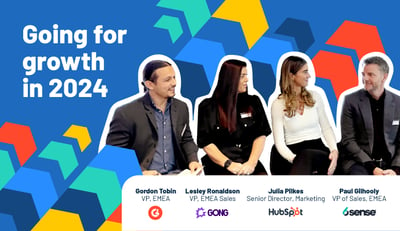December 4, 2024
 by Kerry Cunningham / December 4, 2024
by Kerry Cunningham / December 4, 2024

B2B marketing and selling have not been able to keep up with changes in buyer preferences. Despite the change in how buyers make decisions, marketing teams still focus on generating leads, and sales teams hound those leads for meetings in the belief that this is the path to revenue.
I have spent the last 11 years examining how B2B buying and selling works. As an analyst at SiriusDecisions and other providers, I have worked with hundreds of organizations. Now, at 6sense, I do primary research and engage with revenue teams as a researcher and thought leader.
The team at 6sense conducted two years of buyer research, which shows that this approach is outdated. And here’s what we know from our B2B Buyer Experience Report (all statistics cited in this article come from the report), which was conducted in both 2023 and 2024 across APAC, EMEA, and North America:
Buying groups, in 81% of their B2B purchases, are spending over two-thirds of their purchasing journey conducting independent research, internally evaluating vendors, and identifying their preferred supplier before engaging in conversations with any sales team.
Let’s explore some of the report’s most eye-opening insights, which shed light on how buyers navigate and control their journey:
These findings highlight a major shift in B2B buying dynamics, with buyers controlling most of the journey before engaging with sales. Revenue teams must now rethink their approach to align with these evolved buyer preferences. Let’s explore the implications of this shift.
This fundamental shift has four critical implications for how B2B revenue teams should be structured, how budgets are to be allocated, and how sellers and marketers need to approach their roles in driving revenue.
The data show that the traditional method of generating leads through form fills and passing them to BDRs/SDRs for follow-up is based on the fallacy that we can cause buyers to engage with us just by calling and emailing.
Whereas buyers engage when they’re ready. Hounding them simply does not change when they want to engage. One of the central motions of B2B revenue teams, lead production and follow-up, does not do what it is purported to do — not according to buyers.
And since most leads will come from buyers early on in their journeys, most end up being prematurely disqualified, leading to wasted effort and disastrous metrics for marketing.
A lot of leads can be safely left in peace. They’re people who are either not in the market or are early in their journeys and extremely unlikely to take a meeting. For these, a best practice would be to deliver useful content through email outreach using AI-based automated email tools.
Here, it’s crucial to deliver content and experiences of value. This means that the content should be designed to help buyers understand their business requirements and how you help solve them, not simply to entice them into self-identifying. Provide the option to book a meeting, but that should never be the focus of this outreach.
When leads come from a company’s largest, most important prospects, a more personalized approach may be in order, and a real human might need to be involved. In those largest accounts, SDRs should still be doing the old-fashioned work of mapping the key contacts (buying group members) in the accounts. When signals show that the account really is in-market, adding key contacts and stakeholders to the list of people who receive the buyer-enabling communication will help win that buying group over.
In today’s B2B landscape, marketing’s role is about shaping buyer preferences before they ever engage with a vendor.
When buyers enter a buying journey, they’ve already identified three of the four vendors they plan to evaluate. By the time they speak with your sellers, they’ve already chosen a favorite. This means marketing must focus on influencing these early decisions and ensuring the brand is top-of-mind well before the buying group is ready to engage.
To do this, marketing teams must create valuable, accessible content with deep insights. These insights must answer key questions buyers face during their independent research while guiding buyers toward choosing your brand. Marketing should also continuously build brand awareness and reputation with accounts that aren’t in the market yet so they are better prepared when the buying journey actually begins.
Another step marketing teams need to take is to detect early buying signals. This ensures that content and experiences are used correctly within the buyer journey. This requires investing in systems that track third-party intent data and website activity, and use predictive analytics to identify patterns as the buyer moves throughout the funnel.
By detecting these signals early and nurturing accounts strategically, marketing ensures that when the buying group is finally ready to engage, the vendor is already a trusted option at the top of the shortlist. The result is a seamless handoff to sales, who can focus on validating the buyer’s decision and closing the deal.
In this new buying environment, success requires marketing to play a proactive role in shaping preferences and detecting opportunities while working closely with sales to capitalize on the right moments of engagement.

Every Thursday, we spill hot takes, insider knowledge, and news recaps straight to your inbox. Subscribe here
We have shown that over 80% of buyers hold off on talking to sellers until they establish a preferred vendor. But that leaves nearly 20% of purchases where buyers and sellers do engage before that crucial moment. What’s going on there?
We believe that this largely represents the set of opportunities where sellers had already established themselves as trusted resources prior to the buying journey. So, wherever economically feasible, sales teams should establish relationships with key players inside target accounts before those accounts are in the market. Effective sellers offer content and experiences (e.g., opportunities to engage with industry experts) that genuinely enrich the professional lives of the people they are engaging.
One of the most significant shifts revealed by the report is a two-phase buying journey: the selection phase (first 70%) and the validation phase (final 30%). As described above, buyers form their buying groups, do their research, and choose their preferred vendor during the selection phase. During the validation phase, they engage with vendors to finalize their decision.
This has major implications for budgeting and resource allocation. In times of economic uncertainty, organizations often slash marketing budgets, assuming that sales will compensate by working harder. However, this research suggests that cutting marketing budgets is a mistake.
Instead, organizations should focus on expanding marketing reach and influence during the selection phase while ensuring that sales has the resources to efficiently handle the validation phase. By aligning marketing and sales strategies with the two-phase buying journey, organizations can increase their chances of being the preferred vendor when buyers are ready to engage.
For B2B organizations to succeed in this new environment, they must adopt a buyer-first mentality, focusing on delivering value throughout the buyer journey. Marketing must play a more strategic role in shaping preferences early on, and sales teams must refine their focus to validation rather than persuasion.
Kerry is Head of Research and Thought Leadership at 6sense. As VP Principal Analyst at SiriusDecisions and Forrester, Kerry launched numerous paradigm-shifting models and frameworks (B2B Revenue Waterfall, Buyer Signals Framework) and is a frequent keynote speaker at industry events.
Marketing leaders are increasingly being asked to do more with less, and the scrutiny on...
 by Jenny Gardynski
by Jenny Gardynski
Growth. It’s the topic every sales and marketing leader is focused on right now. We’re coming...
 by Gordon Tobin
by Gordon Tobin
Marketing leaders are increasingly being asked to do more with less, and the scrutiny on...
 by Jenny Gardynski
by Jenny Gardynski



